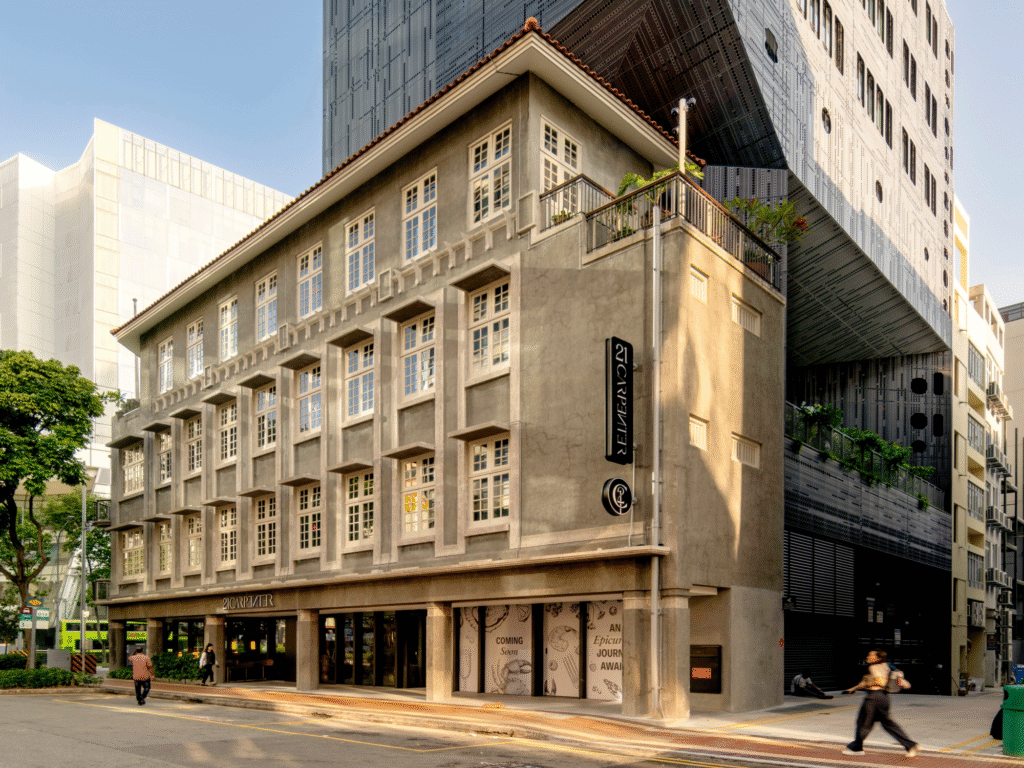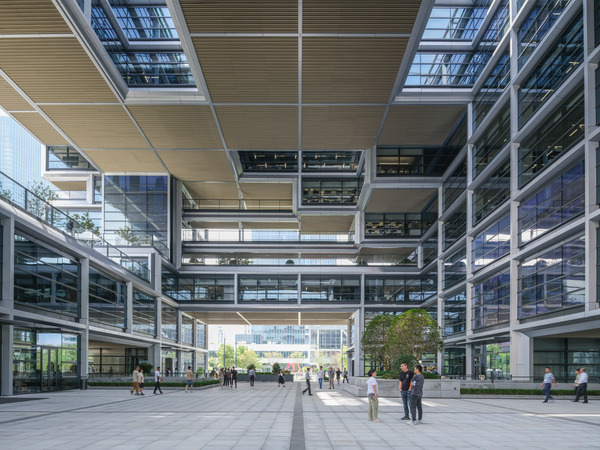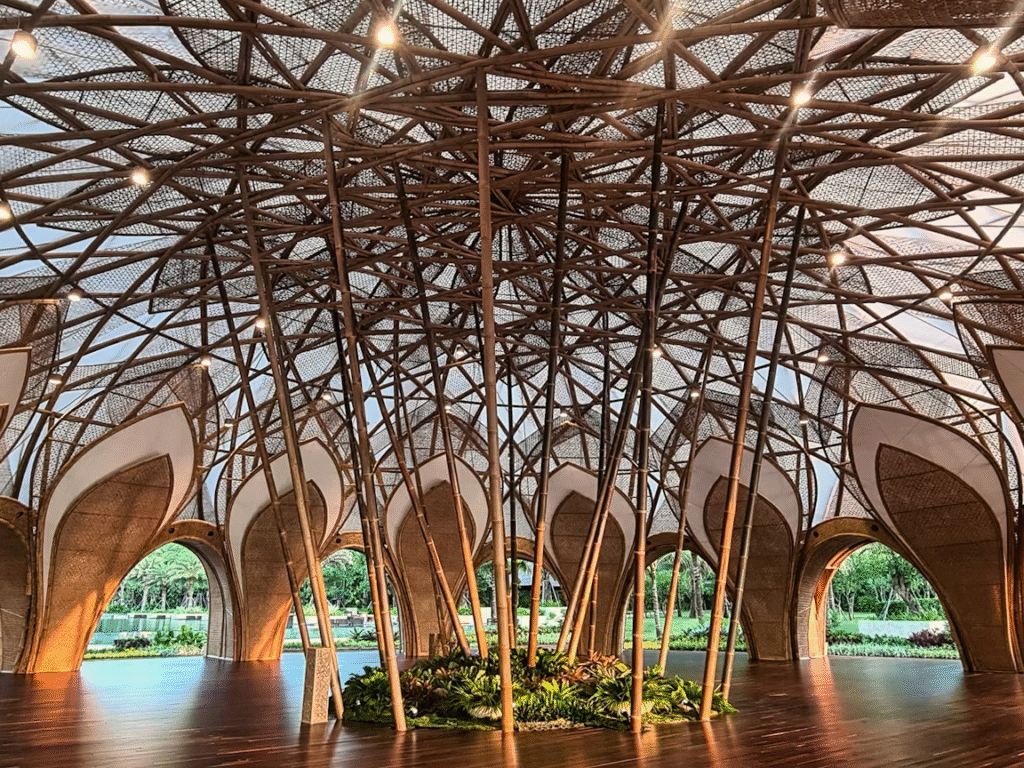China 17 September 2025 – The Royal Institute of British Architects (RIBA) has revealed the 63 finalists for its inaugural Asia Pacific Awards, showcasing some of the most creative and impactful architecture across the region.
The shortlist projects reflect architecture that is deeply embedded in the distinctive cultures and character of the Asia Pacific. As a region on the frontline of complex challenges from climate change to rapid urbanisation, the projects demonstrate how the region is responding, introducing innovative new approaches to living and highlighting how architecture can make a meaningful difference to people’s lives.
From the world’s largest waste-to-energy power plant in China, to a floating university in Bangladesh tackling flood risk and poverty, the shortlist reflects how the region is reimagining its future in socially and environmentally sustainable ways. Projects range from the transformation of anabandoned rural school into a hub for new farmers, to Sydney’s new metro system reflecting natural, indigenous and social history, and the regeneration of historic ceramic factories into a sustainable cultural district – showcasing architecture that bridges tradition with contemporary innovation.
The winners of the Asia Pacific Awards will be announced at the RIBA Architecture Festival Asia (RAFA) on 17 December 2025 in Shenzhen World,during Connexion Shenzhen, a supersized trade exhibition of Catering, Hotel, Furniture, Health, Packaging and lifestyle, organised by IM Sinoexpo. The festival will bring together architects, developers, and policymakers to explore cutting-edge ideas, with live judging sessions leading up to a gala dinner where the winners will be announced.
Spanning 13 countries – including Australia, Bangladesh, China, India, Japan, Singapore, Sri Lanka, and Vietnam – the shortlist brings together talent from across the Asia Pacific and beyond, with projects designed by practices from the region as well as the UK, USA, and Europe.
Regenerative design
From tackling waste to building climate resilience, many shortlisted projects put sustainability at their core. The Shenzhen Energy Ring by Schmidt Hammer Lassen and Gottlieb Paludan Architects converts 5,000 tons of waste a day into clean power, while in Dhaka, BRAC University by WOHA, floats above a restored lake, creating green space and flood protection for 20,000 students and the local community. On Hong Kong’s Yim Tin Tsai Island, the E.CO Rotunda revives bamboo traditions and Hakka culture to preserve indigenous landscapes in a contemporary gathering space, and in India, the DY Patil University Centre of Excellence by Foster + Partners combines shaded courtyards, a vast rooftop garden and ulta-low water to create a low-impact campus for 3,000 students.

Design for community and culture
Other projects reimagine how buildings can support people and traditions. In Bangladesh, the Zebun Nessa Mosque By Studio Morphogenis Ltd. is the country’s first net-zero mosque, blending worship with women’s empowerment and ecological stewardship. In India, the Bandhan Residential School of Business by Abin Design Studio incorporates farming and gardens that feed its community and sustain local livelihoods. In China, villages and schools are being revived: the Revitalization of Yong’an Village by the College of Architecture and Urban Planning of Tongji University, combats poverty and strengthens Bai heritage through education and cultural spaces, while the Dialogue with Nature—Commune STORE by Atelier Global (Mount Wuyi, Fujian) transforms an abandoned school into a hub for farmers and community life.

Urban revitalisation
In cities, architects are finding new life for historic and underused spaces. The Taoxichuan Ceramic Culture Industrial Park by Jie Zhang, Beijing An-Design Architects and THUPDI (China), turns former historic ceramic factories into a vibrant cultural district, supporting local jobs and tourism, whilst preserving the city’s heritage. Sydney’s Waterloo Metro Station by John McAslan + Partners uses the area’s Indigenous, natural, and social history to connect underground platforms with the city above. In Shenzhen, the Qianhai Museum by the Architectural Design and Research Institute of SCUT (Shenzhen) and Shenzhen Lotus Cultural Base by NODE Architecture & Urbanism, are reshaping public infrastructures into accessible, educational landmarks that connect communities with their heritage, nature, and urban surroundings.
AI, tech and innovation
The shortlist also showcases cutting-edge use of AI and digital design. In Singapore, The GEAR by KAJIMA DESIGN, is a “smart wellness building” that uses AI, sensors, and data to continuously adapt to its users. In China, the Rui Xue Multi-Hall by College of Architecture and Urban Planning, Tongji University, combines robotic fabrication and prefabricated timber to create a sculptural community space that blends seamlessly into its rural landscape.
Ziyu Zhang, Founding Partner of Büro Ziyu Zhuang and Jury Chair for the Design for Living category:“These projects are firmly rooted in the distinctive cultures and genius of the Asia Pacific region, exemplifying exceptional execution and a complete, cohesive cycle from concept to lived experience. Meanwhile these buildings serve as powerful narrative media that express local identity, while their typological diversity and strategic innovation introduce fresh paradigms for living and foster community through thoughtfully designed public spaces. Demonstrating strong leadership and vision, these works enrich cities and meaningfully advance the discourse on contemporary living.”
Chris Williamson, RIBA President, said: “The inaugural Asia Pacific Awards celebrate the incredible diversity and creativity of architecture across the region. These projects show how design can respond to complex social, cultural, and environmental challenges, from revitalising communities and preserving heritage, to pioneering sustainable and technologically innovative solutions. They demonstrate the power of architecture to connect people, strengthen identity, and create inclusive, resilient places for future generations.”
Projects will be shortlisted across ten categories, these include: Adaptive Reuse; AI-Powered Design; Design for Living; Future Projects; Mixed-Use; RIBA Member; Social Architecture; Sustainability and Resilience; Temporary Architecture; and Urban Regeneration. Notably, categories such as Future Projects, Temporary Architecture, and AI-Powered Design will debut for the very first time, reflecting the evolving priorities and shifts in how architecture is designed and built for current and future generations.

The complete shortlist, outlining the projects, their architectural practices, and the categories in which they have been recognised, is as follows:
| Project name | Architectural practice | City/Region | Category |
| 21 Carpenter | WOHA | Singapore | Adaptive Reuse |
| Alibaba Shanghai Campus | Foster + Partners | Shanghai, China | AI Powered Design |
| Angan (Courtyard) House | Sunil Hu’mane | Pune, India | Design for Living |
| Bamboo Dome for G20 Bali Summit | BIROE, Celsius Creative Lab, Pacto Convex, and Bamboo Artisans from Desa Belega BlahBatuh Gianyar Bali | Badung Regency, Bali | Temporary Architecture |
| Bandhan Residential School of Business | Abin Design Studio | Bolpur, India | Design for Living |
| Begonia Inn | atelier mearc | Chenzhou, China | RIBA Member |
| BRAC University | WOHA | Dhaka, Bangladesh | Sustainability, Resilience and Urban Regeneration |
| Bridge of Nine Terraces | Scenic Architecture Office | Nanjing, China | RIBA Member |
| CapitaSpring | CapitaSpring | Singapore | Mixed Use, RIBA Member |
| Chaichanglong Historic Area Urban Regeneration (Fairy Li) | SpActrum | Shaoxing, China | Urban Regeneration |
| Changning Bamboo Culture Center | Tongji Architectural Design (Group) Co., Ltd. | Yibin City, China | Social Architecture, Sustainability and Resilience |
| Chapel of Music | Vector Architects | Qinghuangdao, China | Social Architecture |
| Darwin Bucky | andblack design studio | Ahmedabad, India | Temporary Architecture |
| Dialogue with Nature—Commune STORE | Atelier Global | Mount Wuyi, China | Adaptive Reuse, Social Architecture, Sustainability and Resilience |
| DY Patil Centre of Excellence | Foster + Partners | Maharashtra, India | Sustainability and Resilience |
| E.CO Rotunda | Department Of Architecture, The University Of Hong Kong | Hong Kong, China | Temporary Architecture |
| Futabasou Apartments | Futabasou Apartments | Tokyo, Japan | Design for Living |
| GREEN HILL——Transforming Closed Technological Industrial Remains into an Open and Shared Ecological Complex | Tongji Architectural Design (Group) Co., Ltd. | Shanghai, China | Adaptive Reuse |
| Hanaju Renovation | MARU.architecture | Tokyo, Japan | Adaptive Reuse |
| Hong Shou Fang | Plus 8 | Shanghai, China | Urban Regeneration |
| HOUSE OF MEMORIES | Studio Gravitas in collaboration with Eleemente & Bodh Design Group | Tumkur, India | Design for Living |
| Jingdezhen Taoxichuan Cloud Engine Energy Center | XING DESIGN | Jingdezhen City, China | RIBA Member, Social Architecture, Urban Regeneration |
| Liangmao Village Renovation | NODE Architecture & Urbanism | Shenzhen, China | Urban Regeneration |
| Lishui Guyanhuaxiang Art Center | Meng Fanhao / line+ studio | Lishui, China | Social Architecture |
| Macau M8 | The Oval Partnership Ltd. | Macau | RIBA Member |
| MixC | Lead8 – Architect | Nanjing, China | Mixed Use |
| MONOSPINAL | Makoto Yamaguchi Design | Taito-ku, Japan | Mixed Use |
| Nanya Middle School Library | CMIE LUO JIN STUDIO | Changsha, China | RIBA Member |
| Northcote House | LLDS Architects | Northcote, Melbourne, Australia | AI-Powered Design |
| OH HO Residence | Play Architecture | Bangalore, India | Design for Living |
| O-NES TOWER | THAI OBAYASHI CORPORATION LIMITED + THAI OBAYASHI DESIGN COMPANY LIMITED | Bangkok, Thailand | Mixed Use |
| Parikrama | SPASM Design Architects | Nandgaon, India | Design for Living |
| Qianhai Museum | Architectural Design and Research institute of SCUT Co., Ltd. | Shenzhen, China | Future Projects |
| Revitalization of Village Heritage in Yong’an Village | College of Architecture and Urban Planning, Tongji University | Dali City, China | Adaptive Reuse, Mixed Use, RIBA Member, Social Architecture, Sustainability and Resilience |
| Rockbund | ROCKBUND | Shanghai, China | Urban Regeneration |
| Rui Xue Multi-Hall | College of Architecture and Urban Planning, Tongji University | Chengdu, China | AI Powered Design, RIBA Member |
| Sarvasva | SPASM Design Architects | Mumbai, India | Design for Living |
| Seaside Pavilion on Chai Shan Island | GN Architects | Zhoushan City, China | Temporary Architecture |
| Shenzhen Energy Ring | Schmidt Hammer Lassen, Gottlieb Paludan Architects | Shenzhen, China | Sustainability and Resilience |
| Shenzhen Lotus Culture Base | Design Practice: NODE Architecture & Urbanism | Shenzhen, China | Mixed Use |
| Shenzhen SkyPark | Crossboundaries | Shenzhen, China | Urban Regeneration |
| Soil Tent | Tokyo University of the Arts | Tokyo, Japan | Future Projects |
| Songzhuang Micro Community Park | Crossboundaries | Beijing, China | Urban Regeneration |
| Soul Studio | Palinda Kannangara | Rajagiriya, Sri Lanka | RIBA Member |
| Sydney Metro Central Station Upgrade | Woods Bagot in collaboration with John McAslan + Partners | Sydney, Australia | Adaptive Reuse, RIBA Member, Sustainability and Resilience |
| Taoxichuan Ceramic Culture Industrial Park | Jie Zhang, Beijing An-Design Architects, THUPDI | Jingdezhen City, China | Adaptive Reuse, Mixed Use, RIBA Member, Urban Regeneration |
| Tenjincho place | Hiroyuki Ito | Tokyo, Japan | Design for Living |
| Terra Cotta Workshop | Tropical Space | Quang Nam, Vietnam | Sustainability and Resilience |
| The Blue | Tszwai So | Taipei City, Taiwan | Adaptive Reuse |
| The GEAR | KAJIMA DESIGN | Singapore | AI Powered Design |
| The Grid – repurposing Vietnamese industrial heritage as cultural space | Trung Mai, founder of Hanoi Ad hoc / Ad hoc Practice | Hanoi, Vietnam | Temporary Architecture |
| The Reserve | MonoLab Studio in collaboration with Freight Architects, Light Collab & This Humid House | Singapore | Mixed Use |
| Tianfu AG Expo Scientific Research Office Building | LIU YI | Chengdu, China | RIBA Member |
| Tibet Art Museum | Tongji Architectural Design (Group) Co., Ltd | Lhasa, China | Adaptive Reuse |
| Waterloo Metro Station | John McAslan + Partners | Sydney, Australia | Urban Regeneration |
| Weishan Chongzheng Academy Bookstore of Librairie Avant-Garde | Trace Architecture Office (TAO) | Yunnan, China | Adaptive Reuse |
| West Wusutu Village Community Center in Hohhot | Inner Mongolian Grand Architecture Design Co., Ltd. | Hohhot, China | Social Architecture |
| Wetland Floating Campus – Supporting School in the South Area of Haikou Mangrove Forest | Vector Architects | Haikou, China | Future Projects |
| Wiki World Island Cabins with Families | Wiki World | Wuhan, China | RIBA Member |
| Wulingshan Eye Stone Spring | Vector Architects | Chengde, China | Design for Living |
| Zebun Nessa Mosque: A Spiritual-Social Space between Land and Water | Saiqa Iqbal Meghna / Studio Morphogenesis Ltd. | Savar, Dhaka, Bangladesh | Sustainability and Resilience |
| Zero Carbon Cabin-Forest ranger workstation renovation | China Architecture Design & Research Group Co., Ltd., North China University of Technology | Zhangshanying Town, Beijing, China | Sustainability and Resilience |
| Zhuqueli: Historical Recontextualisation | AESEU | Nanjing, China | RIBA Member, Urban Regeneration |
For more information about the full list, please visit the RAFA website at https://www.rafaevent.com/en/home/shortlists/
About the RIBA Awards
For over 50 years, the RIBA Awards have set the global standard for design excellence and are amongst the most rigorously judged and respected in the world.
This year, RIBA is expanding its prestigious International Awards with the launch of two new categories: the Asia Pacific Awards and the Middle East Awards. This will act as a pilot in the first phase of the new international awards programme to recognise architectural excellence on a global scale.
The winners of the Asia Pacific Awards will be announced at the RIBA Architecture Festival Asia (RAFA) on 17 December 2025, featuring live judging sessions and culminating in a gala dinner where the winners will be announced.
Celebrating the breadth and diversity of the built environment across these territories, the awards offer new opportunities for international recognition. All shortlisted built projects will be eligible to progress towards the RIBA International Prize, the world’s most eminent prize for architecture.
About RIBA Architecture Festival Asia (RAFA)
From December 16 to 18, 2025, the Shenzhen World Exhibition & Convention Center will host a major cross-industry event—RAFA (RIBA Architecture Festival Asia), held alongside Hotel & Shop Plus Shenzhen.
Driven by the rapid economic growth of the Greater Bay Area, Connexion Shenzhen has established itself as a pan-industrial trade platform spanning F&B, hospitality and commercial space, furniture, health, and lifestyle sectors, with far-reaching influence across Southeast Asia. The combined exhibition will span 250,000 sqm, attracting 2,500+ exhibitors and 150,000+ global professional visitors. The Architecture & Building Materials Pavilion will gather leading suppliers, engineering firms, and innovators to showcase cutting-edge solutions in green materials, smart construction, and sustainable design, empowering industry transformation. This collaboration between IM Sinoexpo and the Royal Institute of British Architects (RIBA) will bring together world-renowned architects, designers, hoteliers, and commercial developers in Shenzhen for a landmark celebration of Asian architecture.


